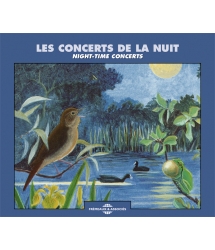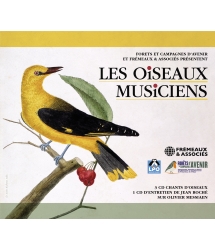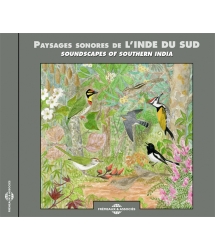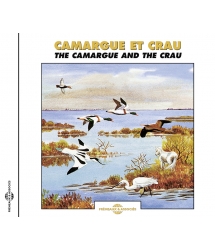- Our Catalog
- Philosophy
- Philosophers of the 20th century and today
- History of Philosophy (PUF)
- Counter-History and Brief Encyclopedia by Michel Onfray
- The philosophical work explained by Luc Ferry
- Ancient thought
- Thinkers of yesterday as seen by the philosophers of today
- Historical philosophical texts interpreted by great actors
- History
- Books (in French)
- Social science
- Historical words
- Audiobooks & Literature
- Our Catalog
- Jazz
- Blues
- Rock - Country - Cajun
- French song
- World music
- Africa
- France
- Québec / Canada
- Hawaï
- West Indies
- Caribbean
- Cuba & Afro-cubain
- Mexico
- South America
- Tango
- Brazil
- Tzigane / Gypsy
- Fado / Portugal
- Flamenco / Spain
- Yiddish / Israel
- China
- Tibet / Nepal
- Asia
- Indian Ocean / Madagascar
- Japan
- Indonesia
- Oceania
- India
- Bangladesh
- USSR / Communist songs
- World music / Miscellaneous
- Classical music
- Composers - Movie Soundtracks
- Sounds of nature
- Our Catalog
- Youth
- Philosophy
- News
- How to order ?
- Receive the catalog
- Manifesto
- Dictionnary











- Our Catalog
- Philosophy
- Philosophers of the 20th century and today
- History of Philosophy (PUF)
- Counter-History and Brief Encyclopedia by Michel Onfray
- The philosophical work explained by Luc Ferry
- Ancient thought
- Thinkers of yesterday as seen by the philosophers of today
- Historical philosophical texts interpreted by great actors
- History
- Books (in French)
- Social science
- Historical words
- Audiobooks & Literature
- Our Catalog
- Jazz
- Blues
- Rock - Country - Cajun
- French song
- World music
- Africa
- France
- Québec / Canada
- Hawaï
- West Indies
- Caribbean
- Cuba & Afro-cubain
- Mexico
- South America
- Tango
- Brazil
- Tzigane / Gypsy
- Fado / Portugal
- Flamenco / Spain
- Yiddish / Israel
- China
- Tibet / Nepal
- Asia
- Indian Ocean / Madagascar
- Japan
- Indonesia
- Oceania
- India
- Bangladesh
- USSR / Communist songs
- World music / Miscellaneous
- Classical music
- Composers - Movie Soundtracks
- Sounds of nature
- Our Catalog
- Youth
- Philosophy
- News
- How to order ?
- Receive the catalog
- Manifesto
- Dictionnary
LARKS ASCENDING
JEAN CLAUDE ROCHE
Ref.: FA626
Artistic Direction : JEAN ROCHE
Label : Frémeaux & Associés
Total duration of the pack : 1 hours 4 minutes
Nbre. CD : 1
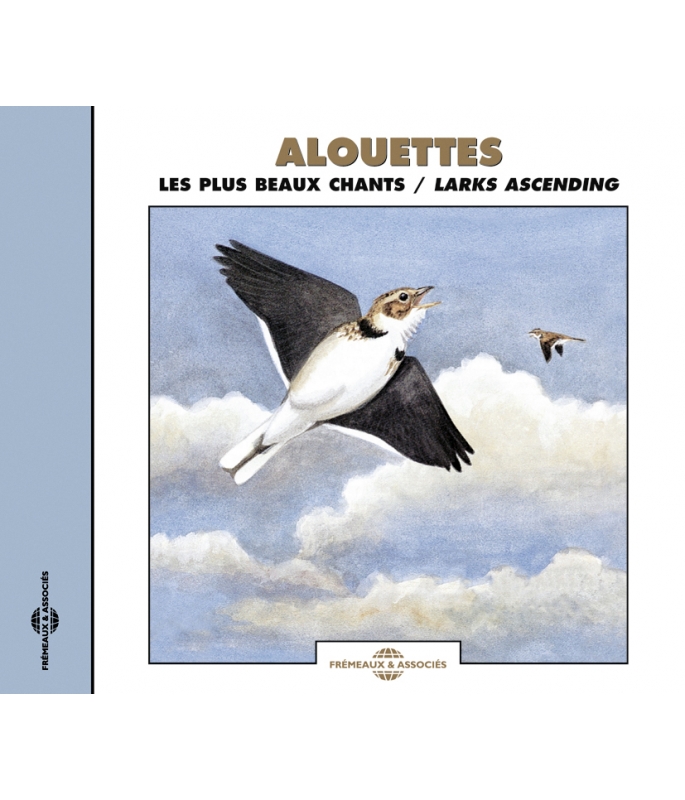
LARKS ASCENDING
LARKS ASCENDING
“We are all familiar with the skylark, the “lark Ascending”. But few are aware that it is just one among many species in the lark family. To look at, they are all rather similar : small and clad in a mixture of earthy browns. But when you hear their songs, how completely different they are ! On this CD you will hear the songs of the nine European species. I have selected the best passages that I ave been able to record over the last 35 years while travelling across Europe !” Jean C. Roché
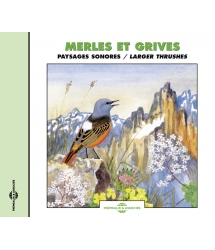
LARGER THRUSHES
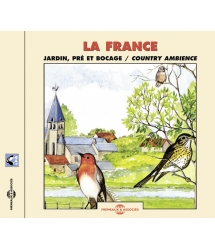
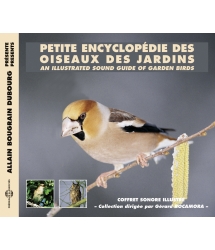
AN ILLUSTRATED SOUND GUIDE OF GARDEN BIRDS
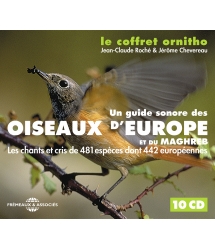
ORNITHOLOGICAL SOUND ENCYCLOPAEDIA :10 CDs




-
PisteTitleMain artistAutorDurationRegistered in
-
1Alouette Lulu Plan de La TourWood Lark (Lullula arborea)00:02:071992
-
2Alouette Lulu Dayet AwaWood Lark (Lullula arborea)00:06:211992
-
3Alouette Lulu ChanacWood Lark (Lullula arborea)00:02:551992
-
4Alouette Lulu VachèresWood Lark (Lullula arborea)00:03:381992
-
5Alouette des Champs NoirmoutierSkylark (Alauda arvensis)00:09:371992
-
6Alouette Calandre HuescaCalandra Lark (Melanocorypha calandra)00:07:481992
-
7Alouette Pistolette HuelvaLesser Short-toed Lark (Calandrella rufescens)00:08:161992
-
8Alouette Calandrelle La CrauShort Toed Lark (Calandrella brachydactyla)00:06:391992
-
9Alouette hausse-col AiligasShore Lark (Eremophila alpestris)00:02:391992
-
10Cochevis Huppé DelphesCrested Lark (Galerida cristata)00:01:581992
-
11Cochevis Huppé Porto LagoCrested Lark (Galerida cristata)00:02:111992
-
12Cochevis de Thekla Cap RederisThekla Lark (Galerida theklae)00:05:561992
-
13Sirli De DupontDupont's Lark (Chersophilus duponti)00:00:561992
-
14Sirli De DupontDupont's Lark (Chersophilus duponti)00:02:111992
-
15Sirli De DupontDupont's Lark (Chersophilus duponti)00:01:181992
ALOUETTES
ALOUETTES
LES PLUS BEAUX CHANTS / LARKS ASCENDING
Introduction
L’aube. Un chant cristallin descend du ciel. On ne voit qu’un petit point noir tremblant et décrivant de grands cercles dans l’azur. L’alouette des champs est allée à la rencontre du soleil et chante à plein poumons ! C’est l’une des images de l’alouette qui nous est la plus familière. Savez-vous qu’il y a 9 alouettes en Europe, et pas moins de 7 en France ? La famille est assez homogène par la petite taille, par la couleur de terre, par la pratique du chant en vol. Mais si vous écoutez les chants, comme ils sont différents ! Vous trouverez dans ce CD les chants des 9 alouettes européennes, j’ai simplement pris les plus beaux passages que j’ai pu enregistrer ces 35 dernières années, à travers l’Europe, jusqu’en Laponie ou en Espagne du Sud. Certains de ces chants sont parmi les plus beaux qu’il est possible d’entendre.
Jean C. ROCHÉ
© 1992 SITTELLE - 2007 FRÉMEAUX & ASSOCIÉS
ALOUETTE LULU (lullula arbores)
Abondante dans toute l’Europe, elle ne manque que dans le nord de l’Angleterre et de la Scandinavie. Elle est sédentaire dans nos régions. Elle aime les landes, friches et prairies sèches avec des arbres. Elle se perche volontiers. Elle chante posée, ou le plus souvent en vol, dansant son chant dans le ciel en un vol festonné. Sa musique mélancolique au timbre pur est toute en nuances, faites de phrases descendantes régulières, séparées ou enchaînées.
Enregistrements :
1. Chant d’un mâle posé, Plan-de-la-Tour, Var, 30 avril 1960. 2’07”
2. Chant d’un mâle posé, Dayet Awa, Maroc, 12 mars 1966. 6’21”
3. Dialogue entre 2 mâles à terre, Chanac, Lozère, 16 juin 1967. 2’54”
4. Chant d’un mâle en vol, Vachères, Haute-Provence, 10 juin 1982. 3’37”
ALOUETTE DES CHAMPS (Alauda arvensis)
Encore plus répandue que la lulu, l’Alouette des champs est sédentaire dans toute l’Europe de l’ouest, sauf en Scandinavie d’où elle s’absente en hiver. Elle aime les prairies, les cultures de céréales, et on la trouve depuis les dunes du bord de mer jusqu’aux toundras alpines à plus de 2?000 mètres. Elle ne se perche pas et émet presque toujours en vol son chant continu, fait de motifs bien ciselés, aigus, répétés une ou plusieurs fois, pendant qu’elle décrit de grandes boucles dans le ciel.
Enregistrement :
5. Chant d’un mâle en vol, Ile de Noirmoutier, Vendée, 9 juillet 1969. 9’38”
ALOUETTE CALANDRE (Melanocorypha calandra)
C’est une grosse alouette méditerranéenne qui a été beaucoup chassée et qui est devenue rare en France (Provence, Corse et Roussillon). Elle est également sédentaire en Espagne, Italie et Grèce. Elle chante parfois au sol, mais le plus souvent en longs vols qui peuvent atteindre de grandes hauteurs. Son chant est continu, puissant, émaillé de cris liquides et grinçants, ainsi que d’imitations d’autre espèces. Ici : Linotte mélodieuse, Chardonneret, Cochevis huppé, Bruant proyer et Alouette calandrelle.
Enregistrement :
6. Chant d’un mâle en vol, Huesca, Espagne, 27 juin 1988. 7’48”
ALOUETTE PISPOLETTE (Calandrella rufescens)
La pispolette est rare en Europe puisqu’on ne la trouve que dans le sud de l’Espagne, dans des milieux très précis : marais salés avec salicornes, terrains secs et ouverts. Elle ressemble à la Calandrelle, et chante comme elle en vol à hauteur assez faible. Elle part hiverner au Maghreb. Son chant est relativement varié, souvent fait de phrases courtes et régulières mais parfois plus longues. Elle imite à merveille les autres oiseaux qu’elle entend : Alouette calandre et calandrelle, Cochevis huppé, Linotte mélodieuse.
Enregistrement :
7. Plusieurs mâles chantant ensemble en vol, Huelva, Espagne, 20 mai 1963. 8’16”
ALOUETTE CALANDRELLE (Calandrella brachydactyla)
Également méditerranéenne mais plus répandue, on la trouve en Espagne, Italie, Grèce et Bulgarie, ainsi qu’en Provence et en Roussillon. Une petite population remonte le long des plages de l’Océan Atlantique de Biarritz à Nantes. Elle nous quitte en hiver. Elle aime les champs secs et pierreux, et les aéroports. Le chant est émis quelquefois posé au sol, le plus souvent en vol à faible hauteur. Un vol tout en crochets et festons ponctué par les phrases courtes et explosives, mais de faible puissance. Certaines sont imitatives, ici le cri du Faucon crécerelle est repris plusieurs fois.
Enregistrement :
8. Un mâle en vol en Crau, 25 mai 1965. 6’39”
ALOUETTE HAUSSE-COL (Eremophila alpestris)
Pour trouver cette jolie alouette en Europe, il faut aller soit sur les sommets des montagnes en Laponie, soit encore sur celles de Grèce (Mont Parnasse notamment), mais l’hiver, on peut apercevoir les migrateurs lapons sur les plages de la Baie de Somme, entre autres rivages marins. Elle chante posée ou en vol, soit des phrases brèves et régulières, suraigües, peu variées, soit un chant continu plus imprévisible (ici à la fin). Ce chant ne s’entend qu’à quelques dizaines de mètres.
Enregistrement :
9. Un mâle en vol à Ailigas, Laponie finlandaise, 25 mai 1963. 2’39”
COCHEVIS HUPPÉ (Galerida cristata)
Autrefois très commun et sédentaire dans toute l’Europe, Scandinavie et Angleterre excepté, cette alouette est en voie de raréfaction car elle se nourrit principalement dans les crottins de chevaux. Elle aime les bords des routes, terrains vagues et champs secs et pierreux. Elle se perche volontiers sur les buissons et les arbres, et peut chanter posée ou en longs vols assez hauts. Le chant est soit continu, soit découpé en phrases plus ou moins longues selon l’excitation de l’oiseau. Le timbre sifflé est monotone, on note parfois quelques imitations, comme ici celle du cri du Petit Gravelot.
Enregistrements :
10. Mâle posé, Delphes, Grèce, 23 avril 1961. 1’58”
11. Mâle en vol, Porto Lago, Grèce, 27 avril 1961. 2’11”
COCHEVIS DE THEKLA (Galerica theklae)
Très proche du Cochevis huppé, le Thékla est en quelque sorte son cousin méridional que l’on trouve en Europe aussi bien qu’en Espagne, où il est sédentaire. On peut trouver quelques petites populations dans le Roussillon, près de la frontière espagnole (Cap Rederis par exemple). Il aime les pentes sèches et caillouteuses avec quelques buissons et arbres. Le chant ressemble à celui du Cochevis huppé mais il est plus chantant, plus varié et un peu plus rapide en général.
Enregistrement :
12. Chant d’un mâle posé, Cap Rederis, Pyrénées Orientales, 25 mai 1962. 5’56”
SIRLI DE DUPONT (Chersophilus duponti)
Le Sirli est une étrange alouette, avec son bec fin et arqué à la manière d’un courlis, et son habitude de courir à terre, invisible même lorsqu’il est très proche. On le croyait nord-africain et récemment il a été trouvé dans les plateaux centraux d’Espagne, en Castille, où il est relativement abondant. Il aime les steppes semi-désertiques et caillouteuses, où il est sédentaire. Il a 2 chants : l’un est bref, 2 fois 2 syllabes, émis de préférence en vol. L’autre est beaucoup plus variable et complexe, émis au sol. Les sons sont un peu yodlés et éraillés, le rythme assez imprévisible, les phrases irrégulières.
Enregistrements :
13. Un mâle en vol, Bergent, Maroc, 23 mars 1967. 0’56”
14. Deux mâles posés proches l’un de l’autre, Embid, Castille, 14 avril 1989. 2’10”
15. Un mâle posé, au même endroit, même date. 1’20”
Mens, le 6 avril 1992
Jean C. ROCHE
© 1992 SITTELLE – 2007 FRÉMEAUX & ASSOCIÉS
english notes
Introduction
Dawn. A crystal-clear song pours down from the sky. A tiny trembling speck can just be made out hovering high in the still morning air. It’s a skylark, rising up to meet the sun, singing at the top of its voice. We are all familiar with the skylark, the “lark Ascending”. But few are aware that it is just one among many species in the lark family.?To look at, they are all rather similar : small and clad in a mixture of earthy browns. But when you hear their songs, how completely different they are! On this CD you will hear the songs of the nine European species. I have selected the best passages that I have been able to record over the last 35 years, while travelling across Europe from Lapland to southern Spain. Some of these songs are among the finest that it is possible to hear.
Jean C. ROCHÉ
© 1992 SITTELLE - 2007 FRÉMEAUX & ASSOCIÉS
WOODLARK (lullula arbores)
Widespread in Europe, but rare in Britain and absent from much of Scandinavia. Resident in the west. Favours heathlands, waste ground, and dry pastureland with scattered trees. Sings from a perch or more often in a dancing, looping display-flight. Its pure, melancholy phrases are subtly nuanced, regular, descending, sung separately or several together.
1. Song of perched male, Plan-de-la-Tour, Var, France, 30 April 1960. 2’07”
2. Song of perched male, Dayet Awa, Morocco, 12 March 1966. 6’21”
3. Dialogue between two males on the ground, Chanac, Lozere, France, 16 June 1967. 2’54”
4. Song of male in flight, Vacheres, Haute-Provence, France, 10 June 1982. 3’37”
SKYLARK (Alauda arvensis)
Much better known than the Woodlark, this species is resident throughout western Europe, except in Scandinavia where it is absent in winter. It inhabits grassland and arable fields, from seaside dunes to Alpine tundra above 2000 m. Virtually always sings in flight, describing wide circles high in the sky. The polished, shrill motifs are uttered once or several times within waves of continuous song.
5. Song of male in flight, Ile de Noirmoutier, Vendee, France, 9 July 1969. 9’38”
CALANDRA LARK (Melanocorypha calandra)
A large Mediterranean lark which has been persistently hunted and is becoming rare in France (Provence, Corsica, Roussillon). Resident in France, Spain, Italy and Greece. Sometimes sings on the ground, but more often in extended flights reaching to a considerable height. The song is loud and continuous, with a mixture of liquid and grating notes and mimicry of other bird sounds : here Linnet, Goldfinch, Crested Lark, Corn Bunting and short-toed Lark.
6. Song of a male in flight, Huesca, Spain, 27 June 1988. 7’48”
LESSER SHORT-TOED LARK (Calandrella rufescens)
Rare in Europe ; confined to the south of Spain, where it occurs in very specific habitats-saltmarshes with Salicornias, and in dry, open areas. It closely resembles the Short-toed Lark, and shares with it a moderate-altitude song-flight. Its song is relatively varied, often made up of short, regular phrases, but sometimes with longer ones. It is a skilful mimic of other birds, eg. Calandra Lark, Short-toed Lark, Crested Lark, Linnet.
7. Several males singing together in flight, Huelva, Spain, 20 May 1963. 8’16”
SHORT-TOED LARK (Calandrella brachydactyla)
A far more widespread species, beeding in all the Mediterranean countries from Portugal to Greece. In France, small numbers are also found on Atlantic beaches as far north as Nantes. It is a rare visitor to Britain. The species inhabits dry, rocky fields, and airports. All European birds spend the winter in Africa. Does sing from the ground, but more often in low-level flight. Birds in song-display rise and fall on the spot, as if on a thread, and give off short, explosive, but somewhat feeble phrases. Some are imitative; here are the call of the Kestrel is repeated several times.
8. A male in flight, la Crau, France, 25 May 1965. 6’39”
SHORELARK (Eremophila alpestris)
To find this attractive lark breeding in Europe requires a trip either to Scandinavia or to Greece, where it is found on mountaintops (eg. Mount Parnassus) and tundra. In autumn the northern birds move down to winter on beaches around the North sea. It sings from the ground or in flight, either with brief, regular, very high-pitched phrases with little variation, or with a continuous, more random series of notes (heard at the end of this recording). The latter song can only be heard from a few metres away.
9. Male in flight at Ailigas, Finnish Lapland, 25 May 1963. 2’39”
CRESTED LARK (Galerida cristata)
Resident throughout Europe except for Britain and Scandinavia. Found along roadsides, on waste ground and in dry, stony fields. Declining in some areas because of changes in agricultural pratice (eg. fewer horses, on whose dung it feeds). Will sing from the ground, or from a perch, or in flight. The song is either continuous or broken up into phrases, which vary in length according to the degree of excitation. The whistling timbre is monotonous. Sometimes it uses mimicry, as here with the call of the Little Ringed Plover.
10. Male perched, Delphi, Greece, 23 April 1961. 1’58”
11. Male in flight, Porto Lago, Greece, 27 April 1961. 2’11”
THEKLA LARK (Galerica theklae)
Closely related to the Crested Lark, but with a more restricted, southern distribution. Resident in Spain and Portugal, with a few in the south of France (Roussillon). It favours dry, rocky slopes with some bushes and trees.
The song resembles that of the Crested Lark, but it is generally more musical and varied, and
slightly faster.
12. Song of perched male, Cap Rederis, Pyrennes Orientales, France, 25 May 1962. 5’56”
DUPONT’S LARK (Chersophilus duponti)
This strange lark has a slender curved bill, and habitually runs along the ground, remaining invisible even when very close. Mainly a north African species, it has recently been found to be fairly common in the central plateaux of Spain, in Castile. It occurs on stony, semi-desert steppes where it is resident.
It has two songs : one is short - 2 times 2 syllables - normally uttered in flight. The other is much more varied and complex, sung from the ground. The sounds are somewhat hoarse and yodelling; the rhythm is unpredictable, the phrases irregular.
13. Male in flight, Bergent, Morocco, 23 March 1967. 0’56”
14. Two males perched close to each other, Embid, Castile, Spain, 14 April 1989. 2’10”
15. One male perched, same place and date. 1’20”
Mens, 6 April 1992
Jean C. ROCHE
Translated in English by Dominic COUZENS
© 1992 SITTELLE – 2007 FRÉMEAUX & ASSOCIÉS
CD ALOUETTES - LES PLUS BEAUX CHANTS / LARKS ASCENDING © Frémeaux & Associés. Droits audio : Frémeaux & Associés - La Librairie Sonore (Producteur initial : Sittelle, Pithys, Collection Allain Bougrain Dubourg ou Ceba) / Ecouter les chants d'oiseaux sur CD : Sons et ambiances naturelles des écosystèmes - Stéreo and digital recording of the natural landscape sound. Natural sound sceneries of écosystems, Voices of the Wild Life. Les droits de cet enregistrement sont protégés par la loi. Pour toute exploitation d’illustration sonore sur CD, DVD, CD-Rom, Télévision, Cinéma, Sites internet, scénographies (théâtre, musées…), l’autorisation et un devis gratuit peuvent être obtenus auprès de Frémeaux & Associés – fax : +33 (0)1 43.65.24.22 info@fremeaux.com
